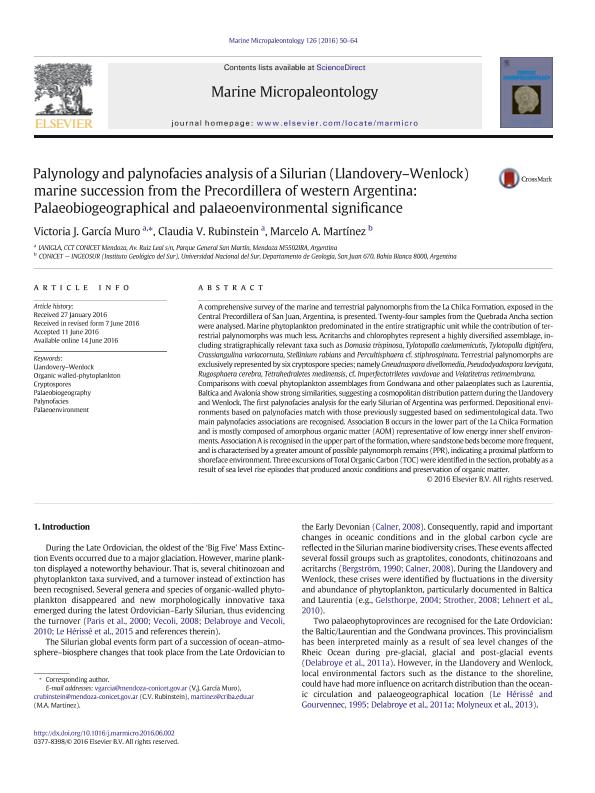Artículo
Palynology and palynofacies analysis of a Silurian (Llandovery-Wenlock) marine succession from the Precordillera of western Argentina: Palaeobiogeographical and palaeoenvironmental significance
Fecha de publicación:
06/2016
Editorial:
Elsevier Science
Revista:
Marine Micropaleontology
ISSN:
0377-8398
Idioma:
Inglés
Tipo de recurso:
Artículo publicado
Clasificación temática:
Resumen
A comprehensive survey of the marine and terrestrial palynomorphs from the La Chilca Formation, exposed in the Central Precordillera of San Juan, Argentina, is presented. Twenty-four samples from the Quebrada Ancha section were analysed. Marine phytoplankton predominated in the entire stratigraphic unit while the contribution of terrestrial palynomorphs was much less. Acritarchs and chlorophytes represent a highly diversified assemblage, including stratigraphically relevant taxa such as Domasia trispinosa, Tylotopalla caelamenicutis, Tylotopalla digitifera, Crassiangulina variacornuta, Stellinium rabians and Percultisphaera cf. stiphrospinata. Terrestrial palynomorphs are exclusively represented by six cryptospore species; namely Gneudnaspora divellomedia, Pseudodyadospora laevigata, Rugosphaera cerebra, Tetrahedraletes medinensis, cf. Imperfectotriletes vavdovae and Velatitetras retimembrana.Comparisons with coeval phytoplankton assemblages from Gondwana and other palaeoplates such as Laurentia, Baltica and Avalonia show strong similarities, suggesting a cosmopolitan distribution pattern during the Llandovery and Wenlock. The first palynofacies analysis for the early Silurian of Argentina was performed. Depositional environments based on palynofacies match with those previously suggested based on sedimentological data. Two main palynofacies associations are recognised. Association B occurs in the lower part of the La Chilca Formation and is mostly composed of amorphous organic matter (AOM) representative of low energy inner shelf environments. Association A is recognised in the upper part of the formation, where sandstone beds become more frequent, and is characterised by a greater amount of possible palynomorph remains (PPR), indicating a proximal platform to shoreface environment. Three excursions of Total Organic Carbon (TOC) were identified in the section, probably as a result of sea level rise episodes that produced anoxic conditions and preservation of organic matter.
Archivos asociados
Licencia
Identificadores
Colecciones
Articulos(IANIGLA)
Articulos de INST. ARG. DE NIVOLOGIA, GLACIOLOGIA Y CS. AMBIENT
Articulos de INST. ARG. DE NIVOLOGIA, GLACIOLOGIA Y CS. AMBIENT
Articulos(INGEOSUR)
Articulos de INST.GEOLOGICO DEL SUR
Articulos de INST.GEOLOGICO DEL SUR
Citación
García, Victoria Josefina; Rubinstein, Claudia Viviana; Martinez, Marcelo Adrian; Palynology and palynofacies analysis of a Silurian (Llandovery-Wenlock) marine succession from the Precordillera of western Argentina: Palaeobiogeographical and palaeoenvironmental significance; Elsevier Science; Marine Micropaleontology; 126; 6-2016; 50-64
Compartir
Altmétricas




